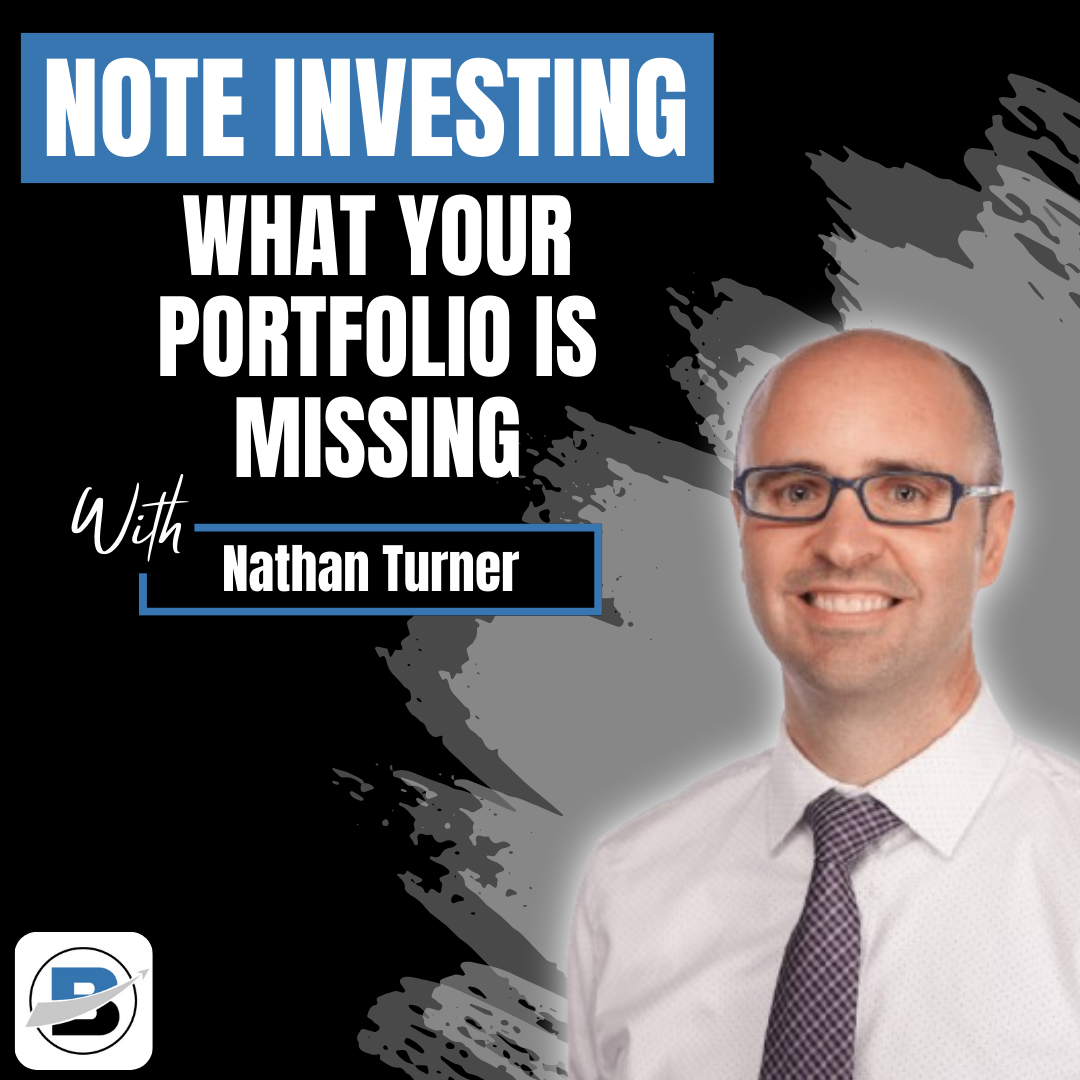Unlocking Passive Income: Building Wealth Through Note Investing
Introduction
In today’s fast-paced business world, young entrepreneurs and small business owners are constantly looking for fresh ways to build wealth and secure financial freedom. Investing in traditional assets like stocks, bonds, or even real estate might already be on your radar, but have you considered note investing? Nathan Turner, known as the "Canadian Note Guy," has mastered this lesser-known approach to generating passive income. In this blog post, we’ll dive deep into note investing, explore how Nathan Turner built a successful career in this niche, and show you how this investment strategy could become a powerful addition to your financial toolkit.
What Is Note Investing?
At its core, note investing is the process of buying and managing debt notes, or the financial agreements behind loans. A note investor essentially becomes the lender by purchasing a mortgage note from a bank or another investor. When you buy a note, you’re buying the right to receive payments on that debt, often with interest. There are two primary types of notes: performing and non-performing.
Performing Notes
These are loans where the borrower is current on payments. They’re less risky and offer steady returns since the borrower has a reliable track record.
Non-Performing Notes
These are loans where the borrower has fallen behind on payments, creating an opportunity to buy the debt at a discounted price. While riskier, these notes allow investors to work with the borrower on a new repayment plan or, in some cases, foreclose on the property, which could lead to significant profits.
For entrepreneurs and business owners, note investing can offer an income stream without the need to manage physical property, which is a common challenge in traditional real estate investing.
Journey into Note Investing
Nathan Turner didn’t start out as a note investing expert; he built his knowledge over time through experience and learning. Initially, Nathan was interested in real estate investing but was drawn to note investing because it offers consistent returns with less hands-on management. Over the years, he developed his expertise, building a note portfolio, through Earnest Investing LP, that eventually led him to create a $5 million fund dedicated to this investment strategy.
Turner’s journey wasn’t without challenges. He recalls learning hard lessons about the importance of due diligence, networking, and adapting to market conditions. Today, Nathan Turner shares his experiences to help other investors understand the nuances of note investing, giving them a roadmap to follow in building a successful investment portfolio.
Why Invest in Mortgage Notes?
For young entrepreneurs and small business owners, note investing can be a smart strategy to generate additional income without adding excessive workload. Unlike real estate investments, which often require property management, repairs, and tenant issues, note investing can be less hands-on.
By investing in notes, entrepreneurs can enjoy passive income that supports other business ventures or personal financial goals. Nathan Turner’s success story demonstrates that even with a smaller fund, note investing can yield consistent, attractive returns.
In a time when young business owners are looking to diversify and secure their financial future, note investing is an option worth exploring. It offers a unique blend of reliability and potential for growth, and it can complement other investment strategies.
The Basics of Building a Note Investment Portfolio
Diving into note investing can be an excellent way to generate passive income and build wealth, but it’s crucial to approach it strategically. Nathan Turner recommends the following steps to help new investors gain confidence and minimize risk:
1. Start Small
Like any investment, jumping in too quickly can lead to costly mistakes. Starting small allows you to learn the ropes while minimizing exposure. How to Begin:
Focus on Performing Notes: These are loans where the borrower is consistently making payments, offering lower risk and steady income.
Set a Budget: Begin with a manageable investment amount that you’re comfortable risking.
Learn as You Go: Use your initial investments as a learning experience, tracking key metrics like payment consistency, yield, and servicing processes.
2. Do Your Due Diligence
Not all notes are created equal; each comes with unique risks. Thorough research helps you identify red flags and make informed decisions. Key Factors to Investigate:
Borrower’s Payment History: Look for consistent payments and low default risk.
Loan Terms: Understand interest rates, maturity dates, and repayment structures.
Collateral Value: If the note is mortgage-backed, assess the property’s current market value to gauge its security.
Geographic Risks: Consider factors like local market conditions, unemployment rates, and property value trends in the area.
Pro Tip: Use tools like title reports and credit reports to verify the borrower and property details.
3. Leverage Servicing Companies
One of the biggest advantages of note investing is that you don’t have to handle collections yourself. Servicing companies are involved in all the following:
Collect payments from borrowers
Handle escrow accounts for taxes and insurance
Issue monthly statements and reports.
Manage delinquencies and, if necessary, foreclosures.
How to Work with Them:
Choose Reputable Companies: Research reviews and performance histories before selecting a servicing partner.
Stay Involved: Regularly review reports and address issues like missed payments promptly.
Build Relationships: Developing a strong partnership with your servicing company can streamline processes and ensure smoother operations.
4. Diversify Your Notes
Diversification reduces risk by spreading your investments across various assets. Key concepts to keep in mind:
Mix Note Types: Invest in both performing and non-performing notes to balance steady income with higher potential returns.
Geographic Variety: Acquire notes in different regions to protect against localized economic downturns.
Loan Variety: Explore residential, commercial, and unsecured notes to add diversity to your portfolio.
Risk Balance: Once you gain quality experience and knowledge, consider exploring non-performing notes, which can offer higher returns but require more expertise to manage.
Additional Tips for Success:
Education is Key: Learn the basics of note investing through books, online courses, or mentorships. Nathan recommends staying informed about market trends and legal requirements.
Build a Network: Join note investor groups or forums to exchange knowledge and gain insights from experienced investors.
Start with a Clear Strategy: Define your investment goals, risk tolerance, and desired return on investment (ROI) before purchasing your first note.
Track Your Performance: Use tools like spreadsheets or investment management software to monitor payments, yields, and overall portfolio performance.
Strategies for Managing and Growing a Note Portfolio
A critical part of managing a note portfolio is timing. Nathan monitors the performance of each note in his fund, ensuring that he holds notes when they’re generating steady returns and knows when to sell them at the right time. This proactive approach is key to maximizing the returns on each note.
One way to keep notes profitable is to focus on shorter-term notes, which tend to generate higher interest payments in the early years. Turner often buys notes, collects payments for a set period, and then resells them once they’ve yielded a steady income. This approach, known as "recycling capital," allows him to reinvest profits into new notes.
Working with servicing companies also helps in managing cash flow. A servicing company collects payments, handles escrow accounts, and provides regular reporting, so investors can focus on strategy rather than day-to-day management. Nathan Turner’s approach to servicing ensures that his portfolio remains efficient and his income stream steady.
Scaling Up: Creating a Note Investment Fund
For Nathan Turner, creating a note investment fund was the logical next step after managing his personal investments. A fund allowed him to scale his operations, attract capital from other investors, and invest in a wider range of notes. His fund, although relatively small at $5 million, serves as a powerful vehicle for generating returns while diversifying risk.
A note fund operates much like a mutual fund, where investor money is pooled together and used to purchase multiple notes. By managing a fund, Nathan is able to buy more notes than he could with just his personal capital. This increases his leverage and gives him greater flexibility in managing his portfolio.
While managing a fund is more complex than handling personal investments, Nathan emphasizes that it opens up opportunities for scalability. For entrepreneurs with investing experience, this could be a compelling way to expand their portfolios and even attract outside investors for larger ventures.
Networking for Success: The Importance of Industry Connections
Nathan Turner stresses the importance of networking for success in note investing. This niche field isn’t crowded, but it does require building strong relationships to succeed. “Relationships, relationships, relationships” is his mantra, as connections can open doors to exclusive deals and provide access to critical insights from seasoned professionals.
For those looking to break into note investing, Nathan recommends attending conferences. Events like these give you a chance to meet other note investors, learn from industry veterans, and stay updated on market trends. Nathan’s own journey began with his attendance at his first note conference in 2009. These connections ultimately helped him gain the knowledge and support he needed to thrive in this specialized field.
Recommended Resources for Aspiring Note Investors
To become proficient in note investing, Turner suggests investing in quality resources. While books and podcasts may not replace hands-on experience, they can be invaluable in getting started.
Books
Invest in Debt by Jimmy Napier
Which is often seen as the foundational text for note investing.
Note Investing Made Easier by Martin Sains
Providing valuable insights into the mechanics of note investing and offer strategies that still apply today.
Podcasts
Nathan co-hosts a podcast with his colleague from JKP Holdings, known as the Real Estate Notes Show. With over three years of episodes, the podcast covers various topics in note investing, often featuring guests who share new insights or advanced strategies.
Whether you prefer reading or listening, these resources can give you the knowledge base you need to dive into note investing with confidence.
Conclusion: Taking the First Step into Note Investing
Nathan Turner’s journey offers valuable lessons for any entrepreneur or small business owner interested in note investing. His story underscores the importance of doing your research, starting small, building connections, and seeking ongoing education. With the right approach, note investing can be an ideal way to build wealth and establish a reliable income stream.
If you’re ready to take that first step, consider researching some of the recommended resources, attending a conference, or connecting with experienced note investors. As Nathan would say, the key is to get involved, learn continuously, and make connections that can support your journey. Note investing may just be the passive income stream that transforms your financial future, one note at a time.

